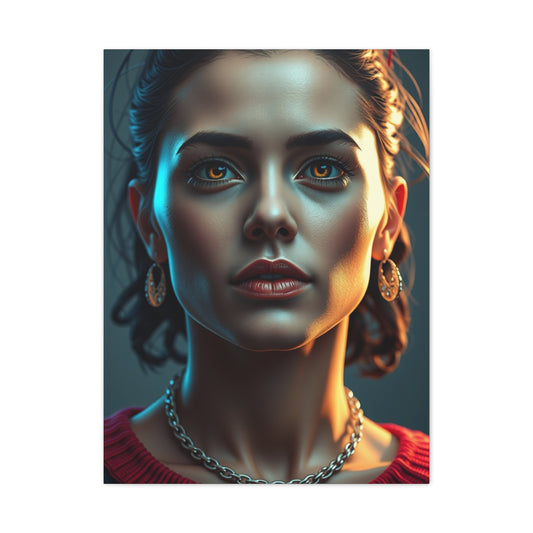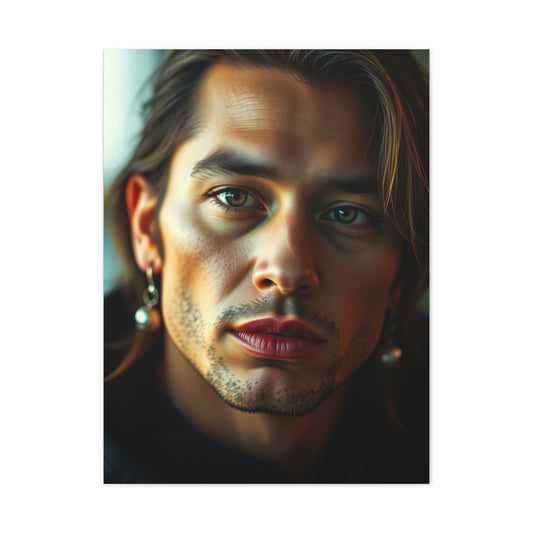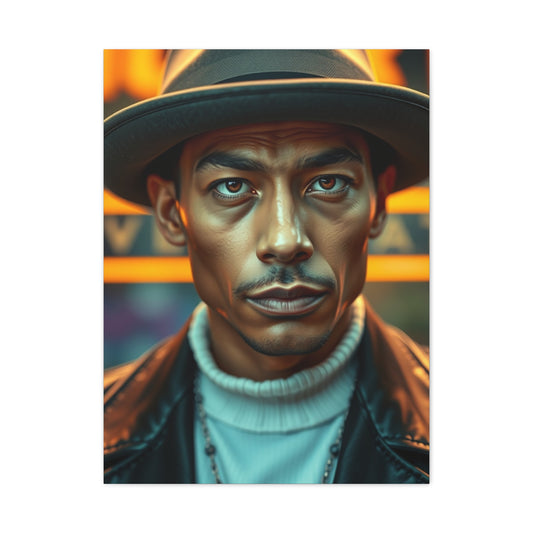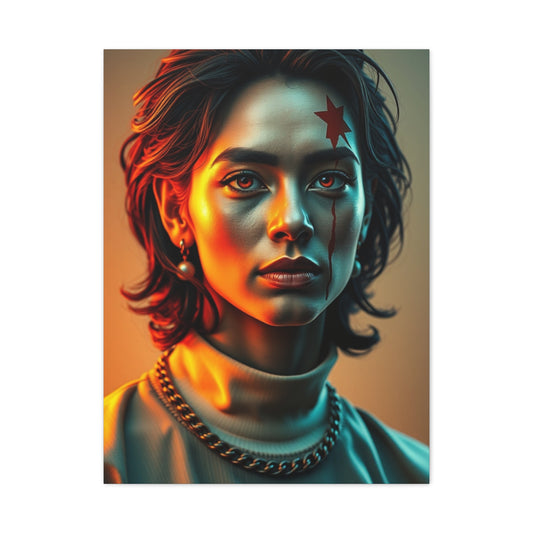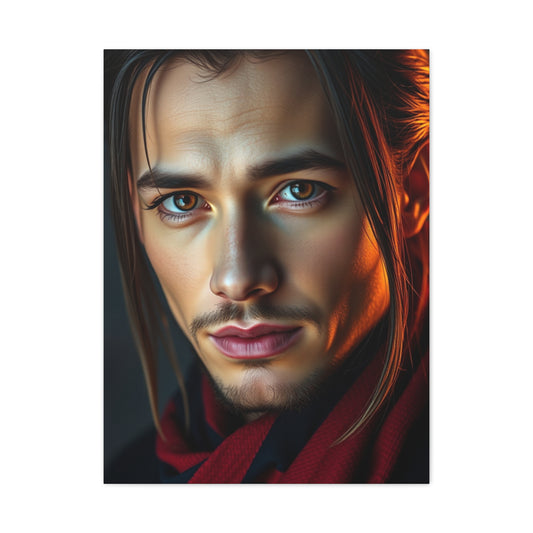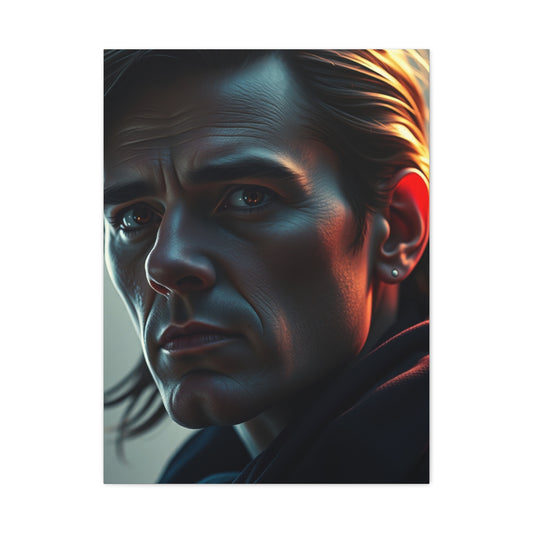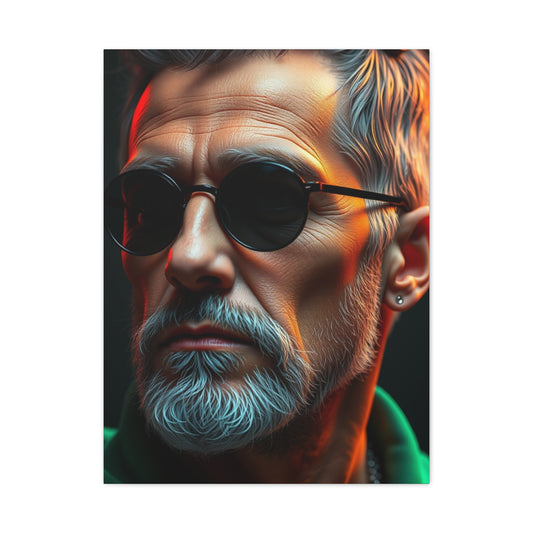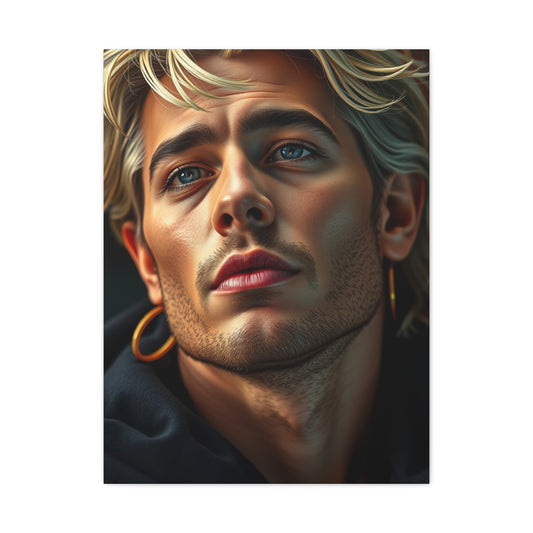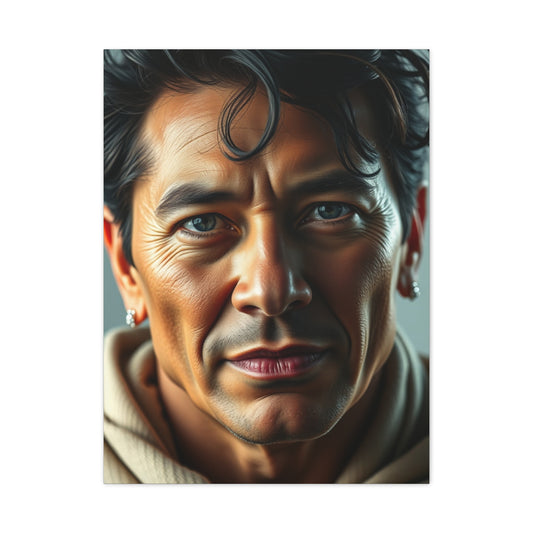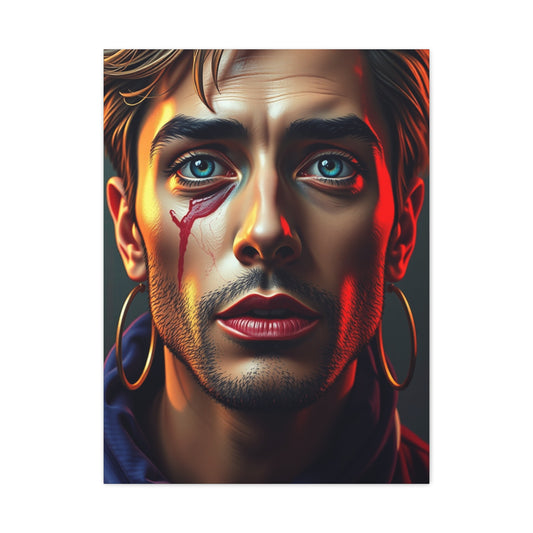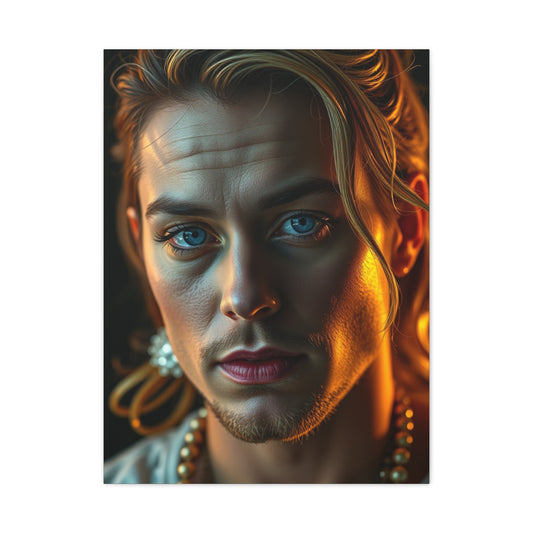Celebrity Wall Art Collectors: Mastering the "Brad Pitt" Style of Art Investment
The mesmerizing phenomenon of celebrity influence extends far beyond entertainment, permeating the sophisticated realm of fine art collection with unprecedented magnetism. When luminaries from Hollywood's elite venture into artistic acquisition, their choices reverberate throughout galleries, auction houses, and investment portfolios worldwide. This cultural metamorphosis transforms mere aesthetic appreciation into a multifaceted phenomenon that simultaneously shapes market valuations, artistic recognition, and investment trajectories.
Celebrity collectors wield extraordinary power in determining which artists achieve mainstream recognition and commercial success. Their purchasing decisions function as cultural endorsements, elevating obscure talents to international prominence while simultaneously creating lucrative investment opportunities for astute collectors who recognize emerging trends. This symbiotic relationship between fame and artistic merit creates a fascinating ecosystem where entertainment celebrity intersects with cultural stewardship.
The psychological underpinnings of this phenomenon reveal humanity's inherent fascination with emulating those we admire. When celebrities demonstrate sophisticated artistic taste, their followers naturally gravitate toward similar aesthetic choices, creating ripple effects that influence everything from gallery exhibitions to auction results. This cultural mimicry extends beyond simple imitation, fostering genuine appreciation for artistic excellence while simultaneously driving market demand.
Brad Pitt's Sophisticated Approach to Contemporary Art Acquisition
Brad Pitt, known globally for his award-winning performances and enduring charisma on screen, has also cultivated a reputation off-screen as a discerning and strategic art collector. Among Hollywood's elite, Pitt stands out not merely for his wealth or celebrity status, but for his deeply thoughtful and informed engagement with the art world. His approach to collecting art reflects a combination of genuine aesthetic appreciation, intellectual curiosity, and strategic financial foresight, making him a significant figure in the contemporary art market.
Pitt's collection is notable for its breadth and depth, spanning various movements and styles—from the raw, expressive energy of street art to the meticulously composed works of contemporary masters. This range reflects his willingness to explore the full spectrum of artistic expression, unconstrained by trends or commercial popularity. He appears drawn to pieces that push boundaries, spark dialogue, and challenge traditional notions of beauty or form. Yet, at the same time, he exhibits a clear preference for works that are technically accomplished, suggesting an appreciation for craftsmanship and artistic discipline. This dual focus—on innovation and execution—sets his collection apart from many celebrity collectors whose purchases often reflect fleeting trends or surface-level interest.
Crucially, Pitt approaches art acquisition not simply as a means of personal enjoyment, but as a strategic form of cultural and financial investment. His selections often involve emerging or mid-career artists poised for greater recognition, indicating a savvy understanding of the art market's dynamics. In many cases, works he has acquired have gone on to increase in value, attesting to his ability to anticipate market movements and identify underappreciated talent. This investment-oriented mindset, balanced with authentic personal taste, reveals a sophisticated collector who understands both the cultural and economic dimensions of contemporary art.
One of the most visible aspects of Pitt’s engagement with the art world is his frequent attendance at major art events, most notably Art Basel in Miami and Switzerland. These appearances are not mere publicity opportunities; they reflect a sustained commitment to staying informed and connected within the global art scene. At such events, Pitt is known to engage directly with artists, gallerists, and curators—asking questions, seeking insights, and building relationships that inform his collection choices. This active participation not only enhances his credibility as a serious collector but also allows him to remain at the forefront of new developments in the art world.
Celebrity Art Collecting
Celebrity art collecting has evolved far beyond the realm of mere aesthetic appreciation. While many celebrities are passionate about the arts, their foray into collecting often intersects with shrewd financial strategy, brand-building, and cultural influence. Stars such as Brad Pitt, Leonardo DiCaprio, Jay-Z, and Beyoncé are notable for their high-profile acquisitions, but their decisions are rarely spontaneous or superficial. These collectors approach the art market with a seriousness akin to institutional investors, guided by long-term goals that balance personal interest, cultural significance, and economic return.
For someone like Brad Pitt, art collecting is both a private passion and a public statement. His acquisitions are not only expressions of personal taste but also strategic moves that add value to his personal brand and financial portfolio. These decisions are based on a complex matrix of factors: the reputation of the artist, the work's historical or cultural importance, current market trends, and potential future appreciation. Unlike traditional investors, however, celebrities bring a unique dynamic to the market—their fame adds an extra layer of value to the works they purchase. When a well-known figure acquires a particular piece, the provenance of that artwork is instantly elevated, making it more desirable to future buyers.
This added “celebrity premium” means that artworks owned by public figures often appreciate at a higher rate. For instance, a painting bought by Brad Pitt can fetch a significantly higher resale price simply due to its association with him. This phenomenon creates a self-reinforcing cycle: the celebrity’s involvement increases demand and visibility, which in turn validates the collector’s eye and investment acumen. Consequently, celebrities not only participate in the art market—they actively shape it.
However, successful celebrity collecting is rarely done in isolation. Behind the scenes, there is often a team of experts—art advisors, curators, financial consultants, and legal specialists—who guide the collector through this highly nuanced market. Art advisors are particularly critical. These professionals help ensure that a collection is cohesive and meaningful rather than a disjointed series of expensive acquisitions. They provide insider knowledge on artists, help with due diligence, authenticate artworks, and advise on timing purchases or sales to align with market conditions.
This collaboration results in collections that are not only valuable but also intellectually and culturally significant. Some celebrity-owned collections rival those of museums, reflecting deep engagement with both contemporary and historical art movements. For example, DiCaprio’s collection includes works by Jean-Michel Basquiat and Takashi Murakami, showing a deep awareness of both market value and cultural relevance.
Sculptural Innovation in Celebrity Collections
Celebrity art collections often reflect more than just an appreciation for beauty or luxury—they serve as statements of personal philosophy, cultural engagement, and intellectual curiosity. One particularly compelling example of this deeper engagement can be found in actor Brad Pitt’s interest in the work of Atelier Van Lieshout, a Dutch art and design collective known for their boundary-pushing sculptural innovations. This collaboration between celebrity collectors and avant-garde artists underscores a significant trend in contemporary art: the merging of aesthetic appreciation with social commentary and radical experimentation.
Atelier Van Lieshout, founded in 1995 by Dutch artist Joep van Lieshout, operates at the intersection of sculpture, architecture, and conceptual art. The collective is renowned for its unorthodox and often controversial creations that explore pressing themes such as autonomy, sustainability, dystopia, and the human condition. Their works often challenge traditional distinctions between art and design, functioning simultaneously as sculptural installations, habitable structures, and philosophical inquiries. For collectors like Pitt—who is known not only for his love of modern design but also for his philanthropic and architectural interests—such art holds immense appeal. It resonates with a desire to engage with pieces that are intellectually stimulating and socially relevant, rather than purely decorative.
One of the defining aspects of Atelier Van Lieshout’s practice is its embrace of utilitarian aesthetics and functional forms. Many of their sculptures are more than objects of visual contemplation—they are designed to be used, lived in, or interacted with. The collective frequently incorporates recycled or sustainable materials in their work and often conceptualizes self-sufficient living environments, complete with energy systems, waste management, and social infrastructure. These ideas align with contemporary global concerns about environmental degradation, overconsumption, and the search for alternative modes of living—making their work especially resonant in today’s sociopolitical climate.
Such themes also strike a chord with celebrity collectors, who increasingly use their platforms and purchasing power to support socially engaged art. When high-profile individuals like Pitt invest in works by collectives such as Atelier Van Lieshout, it sends a message: this is not just about ownership or prestige, but about participating in a broader conversation around art and society. Pitt’s support of this kind of work reflects an understanding that art can be a tool for social dialogue, not just personal enjoyment or status signaling.
Banksy's Street Art Revolution Through Celebrity Endorsement
Brad Pitt's enthusiastic embrace of Banksy's provocative street art demonstrates how celebrity collectors can elevate unconventional artistic movements to mainstream acceptance and commercial success. Banksy's anonymous identity and guerrilla artistic tactics initially positioned his work outside traditional art market structures, making celebrity endorsement particularly crucial for achieving broader recognition and commercial viability.
The mysterious British artist's satirical stencils and elaborate installations challenge conventional notions of artistic value while simultaneously commenting on contemporary social and political issues. When celebrities like Pitt began collecting Banksy's work, they provided crucial validation that helped transform street art from counterculture movement to legitimate artistic genre worthy of serious investment consideration.
This transformation illustrates the democratizing potential of celebrity collecting, where famous patrons can bypass traditional gatekeepers like museum directors and established critics to directly influence artistic recognition. By purchasing and displaying Banksy's work, celebrity collectors created new pathways for artistic legitimacy that circumvented conventional institutional approval processes.
The commercial success that followed celebrity endorsement has fundamentally altered Banksy's artistic trajectory, enabling increasingly ambitious projects while raising complex questions about authenticity and commercialization within street art culture. This evolution demonstrates both the transformative power of celebrity influence and the inevitable tensions that arise when counterculture art achieves mainstream acceptance.
Sculptural Innovation in Celebrity Collections
The Dutch collective Atelier Van Lieshout represents another fascinating dimension of Brad Pitt's collecting interests, showcasing his appreciation for sculpture that challenges conventional boundaries between art, design, and social commentary. Founded by Joep van Lieshout, this multidisciplinary group creates provocative works that explore themes of autonomy, sustainability, and human behavior through innovative sculptural forms.
Atelier Van Lieshout's distinctive approach combines artistic vision with practical functionality, producing pieces that serve as both aesthetic objects and social experiments. Their work often incorporates sustainable materials and self-sufficient systems, reflecting contemporary concerns about environmental responsibility and alternative living arrangements. This alignment with current social consciousness makes their work particularly appealing to celebrity collectors who wish to demonstrate cultural awareness alongside aesthetic sophistication.
The collective's sculptural installations frequently blur boundaries between private and public space, individual and community needs, creating works that provoke discussion about contemporary social structures. Celebrity collectors like Pitt who invest in such provocative pieces demonstrate willingness to engage with challenging artistic concepts that extend beyond mere decoration or status symbols.
The international recognition that has followed celebrity collecting interest has enabled Atelier Van Lieshout to undertake increasingly ambitious projects, from large-scale installations to experimental architectural concepts. This evolution illustrates how celebrity patronage can provide artists with resources and platforms necessary for realizing visionary projects that might otherwise remain unrealized.
Art Basel and the Celebrity Collector Circuit
Art Basel stands as the premier international art fair where celebrity collectors like Brad Pitt regularly appear, creating a sophisticated intersection between entertainment fame and serious artistic engagement. This prestigious annual event brings together the world's most important galleries, collectors, and artists, providing an ideal environment for celebrities to discover emerging talents while demonstrating their commitment to serious collecting.
The fair's carefully curated selection process ensures that participating galleries represent only the highest quality contemporary and modern art, making it an efficient venue for time-constrained celebrity collectors to survey current market offerings. The concentration of exceptional artwork in a single location enables celebrities to compare pieces across different galleries and price ranges, facilitating informed purchasing decisions within compressed timeframes.
Celebrity appearances at Art Basel serve multiple strategic purposes beyond simple acquisition opportunities. These public appearances generate significant media attention that benefits both the celebrities themselves and the artistic community, creating valuable publicity for galleries and artists while reinforcing the celebrities' cultural sophistication. This symbiotic relationship between fame and art world credibility has become an essential component of contemporary cultural dynamics.
The networking opportunities available at Art Basel enable celebrity collectors to build relationships with gallery directors, art advisors, and fellow collectors, creating support networks that enhance their long-term collecting success. These professional relationships provide access to premium artworks before they reach public markets, enabling celebrities to acquire exceptional pieces that might otherwise be unavailable.
The Psychology of Celebrity Art Influence on Consumer Behavior
The profound psychological impact of celebrity art collecting choices on general consumer behavior reveals fundamental aspects of human social dynamics and cultural formation. When prominent figures like Brad Pitt publicly embrace specific artists or artistic movements, their influence extends far beyond their immediate purchases, shaping broader cultural conversations about aesthetic value and investment potential.
This phenomenon operates through multiple psychological mechanisms, including social proof, aspirational identification, and cultural validation. Observers naturally assume that celebrities possess superior knowledge or resources that enable them to make better choices, leading to widespread emulation of celebrity preferences across various cultural domains including art collecting.
The aspirational aspect of celebrity influence motivates individuals to purchase similar artworks as a means of associating themselves with celebrities they admire. This psychological connection creates perceived proximity to fame and sophistication, satisfying deep-seated desires for social elevation and cultural validation. The symbolic value of owning art similar to celebrity collections often exceeds the intrinsic aesthetic or financial value of the pieces themselves.
Celebrity art endorsements also function as cultural permission, legitimizing artistic choices that might otherwise seem risky or unconventional. When respected figures embrace challenging or experimental artwork, they provide psychological cover for others to explore similar aesthetic territories without fear of cultural judgment or financial loss.
Market Dynamics and Price Inflation in Celebrity-Endorsed Art
The market dynamics surrounding celebrity-endorsed artwork create complex pricing mechanisms that often result in significant value inflation beyond what pure aesthetic or art historical merit might justify. When celebrities like Brad Pitt acquire pieces from relatively unknown artists, their purchases immediately establish new price floors that influence all subsequent market transactions for those artists' work.
This price inflation occurs through multiple channels, including increased demand from collectors seeking to emulate celebrity choices, enhanced media exposure that expands awareness of specific artists, and the perceived provenance value associated with celebrity ownership history. These factors combine to create substantial premium pricing that can persist long after the initial celebrity association.
Gallery strategies have evolved to capitalize on celebrity collecting trends, with many establishments actively courting famous collectors and publicizing their purchases to generate broader market interest. This marketing approach leverages celebrity influence to drive sales across entire artist portfolios, creating windfall profits that extend far beyond the individual pieces purchased by celebrities themselves.
The sustainability of celebrity-driven price inflation depends largely on the underlying quality of the artwork and the long-term reputation of the celebrity collector. Purchases by respected figures with demonstrated aesthetic judgment tend to maintain their premium valuations, while acquisitions by celebrities without established collecting credentials may experience more volatile pricing patterns.
Investment Returns and Portfolio Performance Analysis
Analyzing the investment performance of celebrity art collections requires sophisticated methodologies that account for both financial returns and cultural impact metrics. Traditional investment analysis focuses primarily on price appreciation and liquidity considerations, but celebrity collections must also consider the added value created through cultural influence and market-making activities.
Brad Pitt's collection has demonstrated impressive financial performance across multiple artistic categories, with pieces like the Neo Rauch "Etappe" showing substantial appreciation that reflects both the artist's growing reputation and the celebrity endorsement premium. However, measuring true investment success requires longer time horizons that extend beyond immediate market fluctuations to capture sustainable value creation.
The illiquid nature of art markets means that celebrity collectors must adopt patient investment strategies that prioritize long-term appreciation over short-term gains. This approach aligns well with the personal satisfaction aspects of art collecting, where ownership pleasure partially compensates for reduced liquidity compared to traditional financial investments.
Portfolio diversification strategies for celebrity collectors often emphasize artistic variety across different media, time periods, and cultural movements, reducing concentration risk while maximizing opportunities for discovering emerging trends. This diversification approach requires extensive expertise and careful curation to maintain collection coherence while achieving broad market exposure.
The Furniture Design Venture: Extending Artistic Vision
Brad Pitt's collaboration with American furniture designer Frank Pollaro represents a fascinating extension of his artistic interests into functional design, demonstrating how celebrity collectors can leverage their aesthetic development into entrepreneurial ventures. This partnership produces high-end furniture pieces that incorporate design elements inspired by Art Nouveau and Art Deco movements, reflecting Pitt's sophisticated understanding of decorative arts history.
The furniture collection showcases how celebrity involvement in art collecting can evolve into active artistic participation, moving beyond passive acquisition to creative collaboration. This transition requires celebrities to develop deeper understanding of design principles, manufacturing processes, and market positioning strategies that extend far beyond their entertainment industry expertise.
The success of such ventures depends heavily on the celebrity's established credibility within artistic communities and their ability to translate aesthetic preferences into commercially viable products. Pitt's extensive art collecting experience provides crucial foundation knowledge for making informed design decisions that satisfy both aesthetic and functional requirements.
Market reception of celebrity-designed furniture often reflects broader perceptions of the celebrity's artistic credibility and design sensibility. Products associated with respected collectors like Pitt benefit from presumed quality and aesthetic sophistication, while items connected to celebrities without established artistic credentials face greater skepticism from design-conscious consumers.
Art Nouveau and Art Deco Influences in Contemporary Design
The incorporation of Art Nouveau and Art Deco elements in Brad Pitt's furniture collaboration reflects his sophisticated appreciation for historical design movements that continue to influence contemporary aesthetic development. Art Nouveau's organic forms and natural motifs provide timeless design inspiration that translates effectively into modern furniture applications, while Art Deco's geometric precision and luxury materials create products with enduring appeal.
These historical movements offer rich vocabularies of decorative elements, proportional relationships, and material combinations that inform contemporary design decisions while maintaining connection to established artistic traditions. The challenge lies in adapting historical aesthetics to modern functional requirements and manufacturing capabilities without losing essential stylistic characteristics.
Successful integration of historical design elements requires deep understanding of the philosophical and cultural contexts that originally shaped these movements. Art Nouveau's emphasis on craftsmanship and organic integration must be balanced against contemporary efficiency requirements, while Art Deco's luxury orientation must be adapted to current market realities and sustainability concerns.
The enduring popularity of both Art Nouveau and Art Deco demonstrates the timeless appeal of well-executed design that prioritizes both aesthetic beauty and functional excellence. Celebrity endorsement of these movements through contemporary furniture design helps introduce new generations to historical design excellence while creating fresh interpretations for modern applications.
Gallery Relationships and Curatorial Influence
The relationships that celebrity collectors like Brad Pitt develop with galleries and curators play crucial roles in shaping both their personal collections and broader artistic discourse. These professional partnerships provide celebrities with access to emerging talents, market intelligence, and curatorial expertise that enhance their collecting success while simultaneously influencing gallery programming and artistic representation.
Gallery directors recognize the marketing value of celebrity collectors and often provide privileged access to premium artworks, exclusive previews, and personalized consulting services that help celebrities build coherent collections. This preferential treatment reflects the promotional value that celebrity clients bring to galleries through media attention and social validation of artistic choices.
Curatorial relationships enable celebrity collectors to develop deeper understanding of art historical contexts, artistic movements, and cultural significance that inform their purchasing decisions. These educational partnerships transform celebrities from mere buyers into informed patrons who can meaningfully contribute to artistic discourse and cultural development.
The influence flows in both directions, as celebrity collecting preferences can significantly impact gallery programming decisions and curatorial strategies. When respected collectors consistently support certain types of artwork or specific artists, galleries naturally respond by featuring similar pieces and developing relationships with comparable talents.
Authentication and Provenance in Celebrity Collections
The authentication and provenance requirements for celebrity art collections demand exceptional attention to detail and professional expertise, as high-profile ownership creates additional scrutiny and potential targets for forgery attempts. Celebrity collectors must work with established authentication experts, reputable galleries, and recognized institutions to ensure their acquisitions maintain unquestionable legitimacy.
Provenance documentation becomes particularly crucial for celebrity-owned artwork, as future sales will inevitably reference the celebrity ownership period as part of the piece's history. Comprehensive records of purchase circumstances, conservation activities, and display history create valuable documentation that supports long-term value maintenance and facilitates eventual resale transactions.
The insurance requirements for celebrity collections often exceed standard coverage due to enhanced security risks and publicity exposure. Specialized art insurance policies must account for theft risks, public display exposures, and the potential for targeted criminal activity that celebrity ownership might attract.
Conservation considerations for celebrity-owned artwork must balance preservation requirements with the practical demands of ownership, including potential loans to exhibitions, photographer requirements, and security considerations that might affect display and storage conditions.
Cultural Impact and Artistic Legacy Building
Celebrity collectors like Brad Pitt contribute to cultural legacy building through their patronage activities, supporting artistic development while creating permanent cultural contributions that extend far beyond their entertainment careers. This cultural stewardship role positions celebrities as influential figures in shaping aesthetic development and artistic recognition for future generations.
The long-term cultural impact of celebrity collecting includes supporting emerging artists during crucial career development phases, providing financial resources that enable artistic experimentation, and creating visibility opportunities that might otherwise be unavailable. These contributions can fundamentally alter artistic trajectories and cultural development patterns.
Museum relationships and potential donation programs enable celebrity collectors to ensure their collections achieve permanent cultural preservation while providing tax benefits and public recognition for their patronage activities. Strategic donation planning can maximize both personal satisfaction and public cultural benefit while creating lasting legacies.
The educational potential of celebrity collecting extends through media coverage, public exhibitions, and documentary projects that introduce broader audiences to sophisticated artistic content. This educational function helps develop cultural appreciation and artistic literacy across diverse demographic segments.
Global Art Market Trends and Celebrity Influence
International art market trends increasingly reflect the influence of celebrity collectors, whose purchasing patterns help establish pricing benchmarks and cultural preferences across diverse geographical markets. The globalization of celebrity culture means that collecting preferences developed in Hollywood or New York can quickly influence markets in London, Hong Kong, or São Paulo.
Digital media amplification of celebrity collecting activities creates unprecedented global awareness of specific artists, artistic movements, and market opportunities. Social media platforms enable instantaneous worldwide distribution of information about celebrity purchases, creating rapid market responses and international attention for previously unknown artists.
The emerging markets for contemporary art benefit significantly from celebrity collecting validation, as international collectors gain confidence in artistic movements that have attracted sophisticated celebrity attention. This validation effect helps develop new collecting communities and expand global demand for innovative artistic content.
Currency fluctuations and international trade considerations affect celebrity collecting strategies, particularly for acquisitions from international artists or galleries. Sophisticated collectors must consider exchange rate impacts, import duties, and international shipping requirements when building global collections.
Technology Integration in Modern Art Collecting
Contemporary art collecting increasingly incorporates technological tools that enhance research capabilities, authentication processes, and collection management systems. Celebrity collectors leverage these technologies to streamline acquisition processes, maintain comprehensive records, and monitor market developments across global art markets.
Digital platforms provide access to extensive databases of auction results, gallery inventories, and artist biographical information that inform purchasing decisions and market analysis. These resources enable celebrity collectors to conduct sophisticated research that was previously available only to institutional collectors and professional dealers.
Virtual reality technologies and high-resolution imaging systems allow collectors to experience artworks remotely, facilitating international acquisitions and reducing travel requirements for viewing potential purchases. These technologies particularly benefit celebrity collectors whose scheduling constraints might otherwise limit their ability to view artwork in person.
Blockchain technologies and digital authentication systems offer enhanced security for provenance documentation and ownership verification, addressing crucial concerns for high-value celebrity collections that face enhanced scrutiny and potential fraud attempts.
Sustainable Collecting and Environmental Consciousness
Modern celebrity collectors increasingly incorporate environmental consciousness and sustainability considerations into their acquisition strategies, recognizing their platform responsibilities and personal values alignment. This trend reflects broader cultural shifts toward environmental awareness and social responsibility in consumption decisions.
Sustainable collecting practices include supporting artists who use environmentally responsible materials and production methods, prioritizing local and regional artists to reduce transportation impacts, and considering the long-term environmental implications of manufacturing and conservation processes.
The carbon footprint associated with international art acquisition and exhibition requires careful consideration of transportation methods, shipping materials, and exhibition lighting systems. Celebrity collectors can demonstrate environmental leadership through efficient collection management and sustainable display practices.
Supporting artists who address environmental themes through their work creates cultural platforms for important social messages while building collections that reflect contemporary consciousness about ecological challenges and sustainability requirements.
Risk Management and Insurance Strategies
Comprehensive risk management for celebrity art collections requires sophisticated insurance strategies that address unique exposures associated with high-profile ownership, including enhanced theft risks, public scrutiny, and potential market volatility connected to celebrity reputation changes.
Specialized art insurance coverage must account for appreciated values, restoration costs, and liability exposures associated with loans to exhibitions or public displays. The dynamic nature of art valuations requires regular appraisal updates and coverage adjustments to maintain adequate protection.
Security systems for celebrity collections often exceed standard art storage requirements due to heightened public awareness and potential criminal targeting. Integration of advanced surveillance systems, climate control, and access restrictions requires significant investment and ongoing maintenance.
Emergency response planning must address scenarios ranging from natural disasters to security breaches, ensuring rapid protection and recovery procedures that minimize potential losses. These plans require coordination with insurance providers, security professionals, and conservation experts.
Future Trends in Celebrity Art Collecting
Emerging trends in celebrity art collecting reflect broader cultural shifts including increased diversity awareness, technology integration, and social responsibility considerations. Future collecting patterns will likely emphasize artists from underrepresented communities, innovative media applications, and socially conscious artistic content.
Digital art and NFT (Non-Fungible Token) technologies represent significant opportunities for celebrity collectors to engage with cutting-edge artistic developments while potentially achieving substantial investment returns. The intersection of technology and artistic expression creates new categories of collectible content that align with celebrity interest in innovation and trendsetting.
Collaborative collecting ventures between multiple celebrities or celebrity-institutional partnerships may emerge as methods for acquiring museum-quality pieces while sharing costs and expanding cultural impact. These partnerships could enable access to historically significant works while creating innovative patronage models.
The integration of artificial intelligence and machine learning technologies in art market analysis will provide celebrity collectors with enhanced tools for identifying emerging trends, authenticating artwork, and optimizing acquisition timing. These technological capabilities will democratize access to sophisticated market analysis previously available only to institutional collectors.
Conclusion:
The phenomenon of celebrity art collecting, exemplified by Brad Pitt's sophisticated approach to building an impressive collection, represents a fascinating intersection of entertainment culture, artistic patronage, and investment strategy that continues to shape contemporary cultural development. Through their high-profile acquisitions and public engagement with the art world, celebrity collectors create ripple effects that influence market valuations, artistic careers, and broader cultural conversations about aesthetic value and cultural significance.
Brad Pitt's journey from casual art enthusiast to serious collector demonstrates the transformative potential of sustained engagement with artistic excellence. His strategic acquisitions, ranging from Neo Rauch's spectacular "Etappe" painting to Banksy's provocative street art and Atelier Van Lieshout's challenging sculptural works, reveal a sophisticated understanding of both artistic merit and market dynamics that extends far beyond simple celebrity purchasing power.
The million-dollar acquisition of "Etappe" alone illustrates the transformative impact that celebrity collecting can have on individual artistic careers and broader market recognition. Neo Rauch's subsequent international prominence and market success demonstrate how strategic celebrity investment can elevate talented artists from regional recognition to global prominence, creating beneficial outcomes for both the collector and the broader artistic community.
The influence of celebrity collectors extends beyond individual transactions to encompass broader cultural education and artistic accessibility. When respected figures like Pitt publicly embrace challenging or unconventional artwork, they provide cultural permission for broader audiences to explore sophisticated artistic content that might otherwise remain within insular art world circles. This democratizing effect helps bridge the gap between popular culture and high art, creating opportunities for meaningful cultural engagement across diverse demographic segments.
The evolution of Pitt's collecting interests into active design collaboration through his furniture venture with Frank Pollaro represents the natural progression of serious collectors who develop sufficient expertise and confidence to engage in creative production rather than passive acquisition. This transition from collector to creative collaborator demonstrates how sustained engagement with artistic excellence can inspire and enable personal creative development.
The sophisticated integration of Art Nouveau and Art Deco influences in these furniture designs reflects the deep art historical knowledge that serious collecting naturally develops over time. By drawing inspiration from these historically significant movements while adapting their aesthetic principles to contemporary functional requirements, the collaboration creates products that honor artistic tradition while serving modern needs.
The broader implications of celebrity art collecting extend to economic development within artistic communities, where high-profile purchases create enhanced visibility and market confidence that benefit numerous artists, galleries, and cultural institutions. The amplification effect of celebrity attention generates media coverage and public interest that would be impossible to achieve through traditional art world channels alone.
Furthermore, the global reach of celebrity culture means that collecting preferences developed in specific cultural contexts can rapidly influence international markets and artistic recognition patterns. This globalization of artistic taste and market influence creates unprecedented opportunities for cultural exchange and artistic development across traditional geographical boundaries.
The responsibility that accompanies such cultural influence requires celebrity collectors to approach their acquisitions with careful consideration of both personal satisfaction and broader cultural impact. The choices made by influential collectors like Pitt inevitably shape artistic careers, market valuations, and cultural conversations in ways that extend far beyond their immediate personal interests.
Looking toward the future, the integration of technological innovation, environmental consciousness, and social responsibility into collecting practices suggests that celebrity art patronage will continue evolving to reflect contemporary values and opportunities. The potential for digital art, sustainable practices, and collaborative collecting models creates exciting possibilities for expanding the cultural impact of celebrity patronage while addressing current social and environmental concerns.
The enduring legacy of celebrity art collecting ultimately rests on its ability to support artistic excellence while creating cultural bridges that connect diverse audiences with sophisticated aesthetic content. Through their public engagement with the art world, celebrity collectors like Brad Pitt demonstrate that cultural patronage represents not just personal enrichment but also social responsibility and cultural stewardship that benefits society as a whole.
The sophisticated approach that characterizes successful celebrity collecting requires patience, expertise, and genuine commitment to artistic excellence that extends far beyond mere status symbol acquisition. The most respected celebrity collectors distinguish themselves through consistent support for artistic quality, willingness to take calculated risks on emerging talents, and long-term commitment to building coherent collections that reflect both personal taste and cultural significance.
As the art world continues to evolve in response to technological innovation, changing social values, and global cultural integration, the role of celebrity collectors will undoubtedly adapt to reflect these developments while maintaining their essential function as cultural ambassadors who help shape artistic recognition and market development. The Brad Pitt model of sophisticated, research-driven collecting provides an excellent template for future celebrity collectors who aspire to create meaningful cultural impact while achieving personal satisfaction and financial success through artistic patronage.

